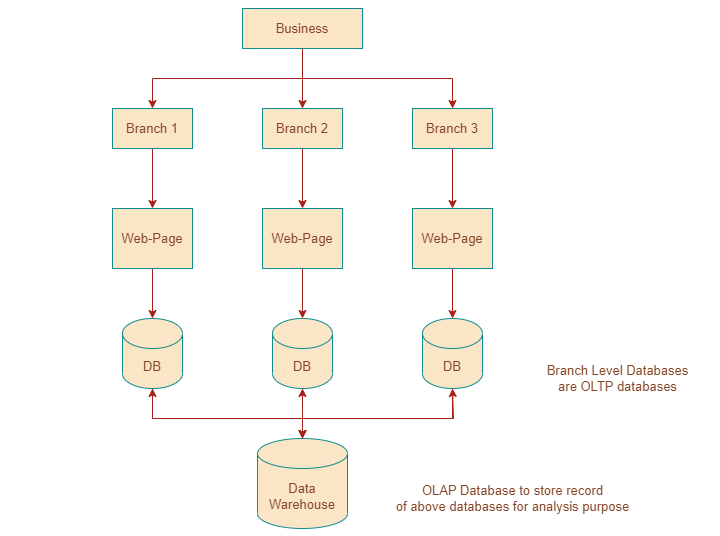
 Data Structure
Data Structure Networking
Networking RDBMS
RDBMS Operating System
Operating System Java
Java MS Excel
MS Excel iOS
iOS HTML
HTML CSS
CSS Android
Android Python
Python C Programming
C Programming C++
C++ C#
C# MongoDB
MongoDB MySQL
MySQL Javascript
Javascript PHP
PHPPhysics
Chemistry
Biology
Mathematics
English
Economics
Psychology
Social Studies
Fashion Studies
Legal Studies
- Selected Reading
- UPSC IAS Exams Notes
- Developer's Best Practices
- Questions and Answers
- Effective Resume Writing
- HR Interview Questions
- Computer Glossary
- Who is Who
On Line Transaction Processing (OLTP) System in DBMS
On-Line Transaction Processing (OLTP) System is a type of computer system that helps manage transaction-related tasks. These systems are made to quickly handle transactions and queries on the internet. For instance, supermarket's POS (point of sale) system is an example of an OLTP system.

Almost every industry nowadays uses OLTP systems to keep track of their transactional data. OLTP systems mainly focus on entering, storing, and retrieving data, which includes daily operations like purchasing, manufacturing, payroll, accounting, etc. Many users use these systems for short transactions. They support simple database queries, which makes it easier for users to get quick responses.

Data that an OLTP system collects is stored in a commercial database management system, which can be used by other systems like OLAP for data analysis and other business intelligence tasks.
Other examples of OLTP systems include order entry, retail sales, and financial transaction systems.
Advantages of an OLTP System
Real-time processing
OLTP systems process transactions in real-time for immediate responses.
High availability
OLTP systems ensure high availability and reliability with redundancy and backup systems.
Data accuracy
OLTP systems maintain data accuracy and consistency through validation and verification techniques.
Fast response time
OLTP systems are optimized for fast response times using indexing and caching techniques.
Scalability
OLTP systems can easily scale up or down to accommodate changes in transaction volume.
Integration with other systems
OLTP systems can be integrated with other systems like OLAP for data analysis and insights.
Challenges of an OLTP system
High concurrency
OLTP systems need to handle high levels of concurrency, with many users accessing the system simultaneously.
Database design complexity
OLTP systems require a complex database design to handle the relationships between different data entities.
Resource utilization
OLTP systems require significant resources such as CPU, memory, and I/O to handle high transaction volumes.
Security concerns
OLTP systems require strong security measures to prevent unauthorized access or data breaches.
Scalability limitations
OLTP systems may have scalability limitations when handling very large transaction volumes or data volumes.
Backup and recovery
OLTP systems require robust backup and recovery systems to ensure data is not lost in case of system failures or disasters.
Type of queries that an OLTP system can Process
Insert queries
OLTP systems can process insert queries that add new data to the database, such as when a customer purchases a product.
Update queries
OLTP systems can process update queries that modify existing data in the database, such as when a customer changes their address.
Delete queries
OLTP systems can process delete queries that remove data from the database, such as when a customer cancels an order.
Simple select queries
OLTP systems can process simple select queries that retrieve data from the database, such as when a customer searches for a product.
Join queries
OLTP systems can process join queries that retrieve data from multiple tables in the database, such as when a customer wants to see all their orders and the corresponding product details.
For example, POS system in supermarket can use OLTP system to add, update or remove information about a customer's purchase. These are some queries examples:
Retrieve the complete description of a particular product from the database.
Filter all the products related to a particular supplier in the database.
Search for the record of any particular customer in the database.
List all products in the database that have a price less than Rs 1000.
OLTP systems are not optimized and efficient for
Complex analytics queries that require processing of large amounts of data.
Generating complex reports that require aggregation, grouping, and sorting of large amounts of data.
In handling historical data that is no longer relevant to current transactions.
In handling large tables with complex relationships that require join queries.
Conclusion
In conclusion, On-Line Transaction Processing (OLTP) System is a computer system used to manage transaction-related tasks. OLTP systems are widely used in various industries to enter, store, and retrieve data, such as purchasing, manufacturing, payroll, and accounting. These systems provide real-time processing, high availability, and data accuracy with fast response times.
However, they also face challenges such as high concurrency, complex database design, resource utilization, security concerns, scalability limitations, and backup and recovery systems. OLTP systems support simple database queries such as insert, update, delete, simple select, and join queries. Nevertheless, they are not optimized for complex analytics queries, generating complex reports, handling historical data, and large tables with complex relationships. Overall, OLTP systems are efficient and essential for short transactions and daily operations, but other systems like OLAP are required for complex analytics and data analysis tasks.

